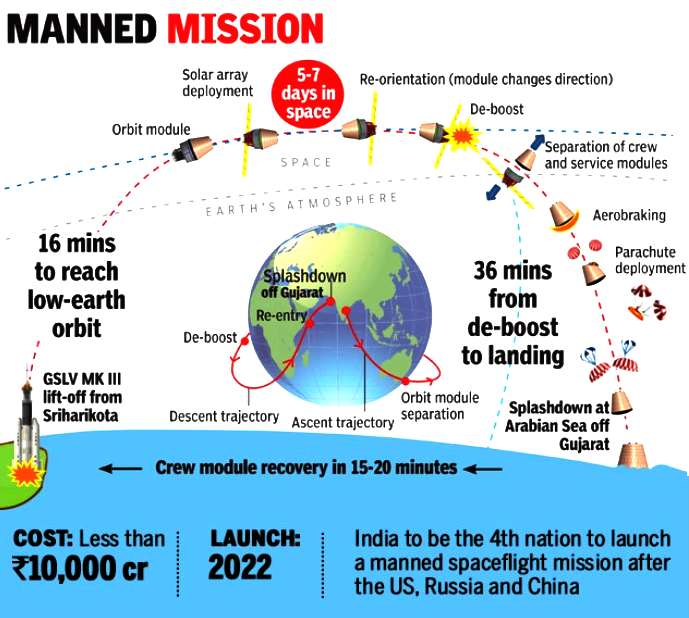Gaganyaan Mission
Why in News
Recently, the Union Minister of Science and Technology informed that the human spaceflight module of Gaganyaan will be launched after the second unmanned mission planned in 2022-23.
- It was initially envisaged that the Rs. 10,000 crore Gaganyaan mission aims to send a three-member crew to space for five to seven days by 2022 when India completes 75 years of independence.
- First unmanned mission is planned in December 2021.
- It has been delayed due to the Covid-19 induced lockdown.
Key Points
- About:
- Gaganyaan is a mission by the Indian Space Research Organisation (ISRO).
- Under the Gaganyaan schedule:
- Three flights will be sent into orbit.
- There will be two unmanned flights and one human spaceflight.
- The Gaganyaan system module, called the Orbital Module will have three Indian astronauts, including a woman.
- It will circle Earth at a low-earth-orbit at an altitude of 300-400 km from earth for 5-7 days.
- Payloads:
- The payload will consist of:
- Crew module - spacecraft carrying human beings.
- Service module - powered by two liquid propellant engines.
- It will be equipped with emergency escape and emergency mission abort.
- The payload will consist of:
- Launch:
- GSLV Mk III, also called the LVM-3 (Launch Vehicle Mark-3,) the three-stage heavy lift launch vehicle, will be used to launch Gaganyaan as it has the necessary payload capability.
- Training in Russia:
- In June 2019, the Human Space Flight Centre of the ISRO and the Russian government-owned Glavkosmos signed a contract for the training, which includes Russian support in the selection of candidates, their medical examination, and space training.
- The candidates will study in detail the systems of the Soyuz manned spaceship, as well as be trained in short-term weightlessness mode aboard the Il-76MDK aircraft.
- The Soyuz is a Russian spacecraft. The Soyuz carries people and supplies to and from the space station.
- The Il-76MDK is a military transport plane specially designed for parabolic flights of trainee astronauts and space tourists.
- In June 2019, the Human Space Flight Centre of the ISRO and the Russian government-owned Glavkosmos signed a contract for the training, which includes Russian support in the selection of candidates, their medical examination, and space training.
- Significance:
- It will help in enhancement of science and technology levels in the country and help inspire youth.
- Gaganyaan will involve numerous agencies, laboratories, disciplines, industries and departments.
- It will help in improvement of industrial growth.
- Recently, the Government has announced a new organisation, IN-SPACe, part of reforms to increase private participation in the space sector.
- It will help in development of technology for social benefits.
- It will help in improving international collaboration.
- One International Space Station (ISS) put up by multiple countries may not be enough. Regional ecosystems will be needed and Gaganyaan will focus on regional needs: food, water and energy security.
- It will help in enhancement of science and technology levels in the country and help inspire youth.
- India’s Other Upcoming Projects:
- Chandrayaan-3 Mission: India has planned a new moon mission named Chandrayaan-3. It is likely to be launched in early 2021.
- Shukrayaan Mission: The ISRO is also planning a mission to Venus, tentatively called Shukrayaan.
